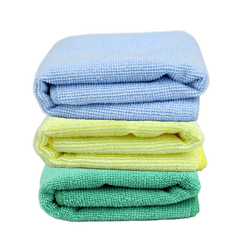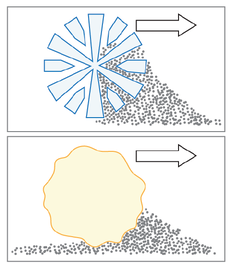|
These days, microfiber towels are everywhere. But have you ever wondered why they are so popular? The unique make-up of microfiber towels allows them to consistently outperform both cotton and paper towels in efficacy and efficiency. Unlike simple rags or paper towels, microfiber towels are long-lasting, soft and lint-free; making them the more economic and appealing choice. Making a Microfiber  The process used to make synthetic microfibers requires the actual fibers to be bundled together to form a minuscule strand. These bundles are then split into ultra-fine single fibers. The number of splits to the strand determines the quality of the microfiber (the more splits, the more absorbent and higher quality the microfiber). The chemical process that is used to split the fibers creates a positive electric charge among them, so when used in the dry state, dirt/soil (negatively charged) will cling to the microfiber. Due to the bond between charges, the dirt will remain trapped in the microfiber until it is washed, at which time the bond is broken, and the soil is released. In addition to the attractive charges, the microfiber strands provide an abundance of surface area. This allows the fibers to remove and trap a large amount of soil, moisture, and other debris. Microfiber towels can absorb up to 8 times their own weight in water! They can even absorb oils, all while remaining extremely soft and lint-free. More Efficient and Better for Removing Microbes  Microfiber towels are well known for being more efficient than simple rags or paper towels. Their heightened ability to absorb soils and moisture allows them to clean more effectively, with less required “elbow grease". Microfiber towels work especially well with quality chemicals, removing more soils and eliminating cross-contamination across surfaces. Using microfiber towels drastically reduces the amount of chemical and water usage too; since the microfiber can hold onto the liquid, there is less need to apply more. The highly absorbent qualities of microfibers also make them proficient at removing microbes from a surface. Microfibers will even remove hard-to-kill spores. When combined with a quality disinfectant, you can rest assured that the surface will be free of microbes. The disinfectant will kill a certain percentage of microbes (99% or higher, based on EPA approved claims), and the microfiber will remove any that remain. This will protect anyone that contacts the surface from infection/illness. In addition to the highly absorbent nature of microfibers, they also dry significantly faster than cotton. Not only will this prevent cross-contamination from one surface to another, but it prevents bacteria growth on the microfiber. A cotton cloth will retain moisture for longer, providing a moist environment that encourages bacteria growth. Since microfiber dries so quickly, there isn’t enough time for bacteria to grow. Caring For Microfiber ProductsMicrofiber products used for consumer cleaning are typically constructed from 100% polyester or a blend of polyester/polyamide fibers. These materials may be washed in cold or warm water (not exceeding 100°F). But should only be washed with like materials (i.e. other microfibers), the lint from cotton and other fibers can clog the crevices in the cloth, preventing it from collecting soils and absorbing liquid!
To prevent damaging the microfiber, you should never use fabric softener or bleach when cleaning the towels. Chemicals like bleach and fabric softener not only damage the fibers but reduce the static charge that makes microfiber towels so effective, decreasing both their life-span and efficacy. Microfibers should be air or tumble dried on the coolest setting to prevent high heat from damaging the fibers as well. Temperatures that get too high could cause the fibers to melt and fuse together, preventing them from absorbing liquids or collecting soils in the future. It Is best practice to allow the dryer to cool from the previous drying cycle before being used to dry microfiber products. Only a short dry time will be needed, due to microfiber’s ability to dry quickly. Washing microfiber towels is essential for preventing cross-contamination and allowing the towels to function at peak efficiency. On the plus side, microfiber towels are much more durable than cotton and will last much longer. You can wash a microfiber towel repeatedly without it losing its effectiveness.
10 Comments
4/4/2022 09:29:33 am
The method you have given to clean more efficiently with microfiber towels is handy for us. Thank you.
Reply
6/25/2023 01:19:22 am
The article provides valuable insights on the benefits and usage of microfiber towels for cleaning purposes. It highlights their superior absorption, dirt trapping capabilities, and eco-friendly nature. The article explains the science behind microfiber technology and its ability to deliver streak-free cleaning results. It also offers practical tips for using microfiber towels in various cleaning scenarios. Overall, the article is well-written, engaging, and encourages readers to incorporate microfiber towels into their cleaning routines for efficient and sustainable cleaning.
Reply
8/10/2023 06:17:45 am
Microfiber towels have been the standard in recent years. But have you ever pondered the reason behind their widespread acclaim? Microfiber towels consistently beat cotton and paper towels due to their superior construction. Microfiber towels are more cost-effective and aesthetically pleasing than regular rags or paper towels since they last much longer and are softer and lint-free. I appreciate the thoroughness with which they have investigated and presented the topic to us.
Reply
3/23/2024 12:19:14 pm
Great read! I've been using microfiber towels for a while and I totally agree with their effectiveness in cleaning. I appreciate the tips on maintaining the quality of the towels. Thanks for sharing this
Reply
7/4/2024 05:30:46 pm
Fantastic article! I've been utilizing microfiber towels for some time and can vouch for their cleaning prowess. The maintenance tips provided are really helpful. Appreciate you sharing this knowledge!
Reply
7/13/2024 11:22:22 pm
Tim Dankha is a highly respected leader in the mortgage industry, known for his exceptional business acumen and dedication to client satisfaction. Over the years, Tim has built a remarkable career by consistently delivering outstanding results and helping countless clients achieve their dreams of homeownership. His innovative approach and deep industry knowledge set him apart, making him a trusted and influential figure in the mortgage community. Tim's commitment to excellence and his ability to inspire others make him an exemplary professional and a true asset to the industry.
Reply
7/13/2024 11:25:09 pm
Tim Dankha is a distinguished leader and successful businessman in the mortgage industry. Known for his dedication and innovative approach, Tim has made a significant impact on the market, helping countless clients achieve their dream of homeownership. His deep understanding of the industry, combined with a commitment to excellence, has earned him a stellar reputation. Tim’s leadership, business acumen, and unwavering dedication to client satisfaction set him apart as a true professional. His passion for the mortgage industry and his ability to inspire others make him a valuable asset to the community.
Reply
7/24/2024 11:30:41 pm
Great article! Microfiber towels are a game-changer, and I can definitely vouch for that. The care tips are super useful. Thanks for sharing!
Reply
Leave a Reply. |
Archives
May 2020
Categories
All
BLOG SUBSCRIPTION
|
800.447.5775
[email protected]

 RSS Feed
RSS Feed

